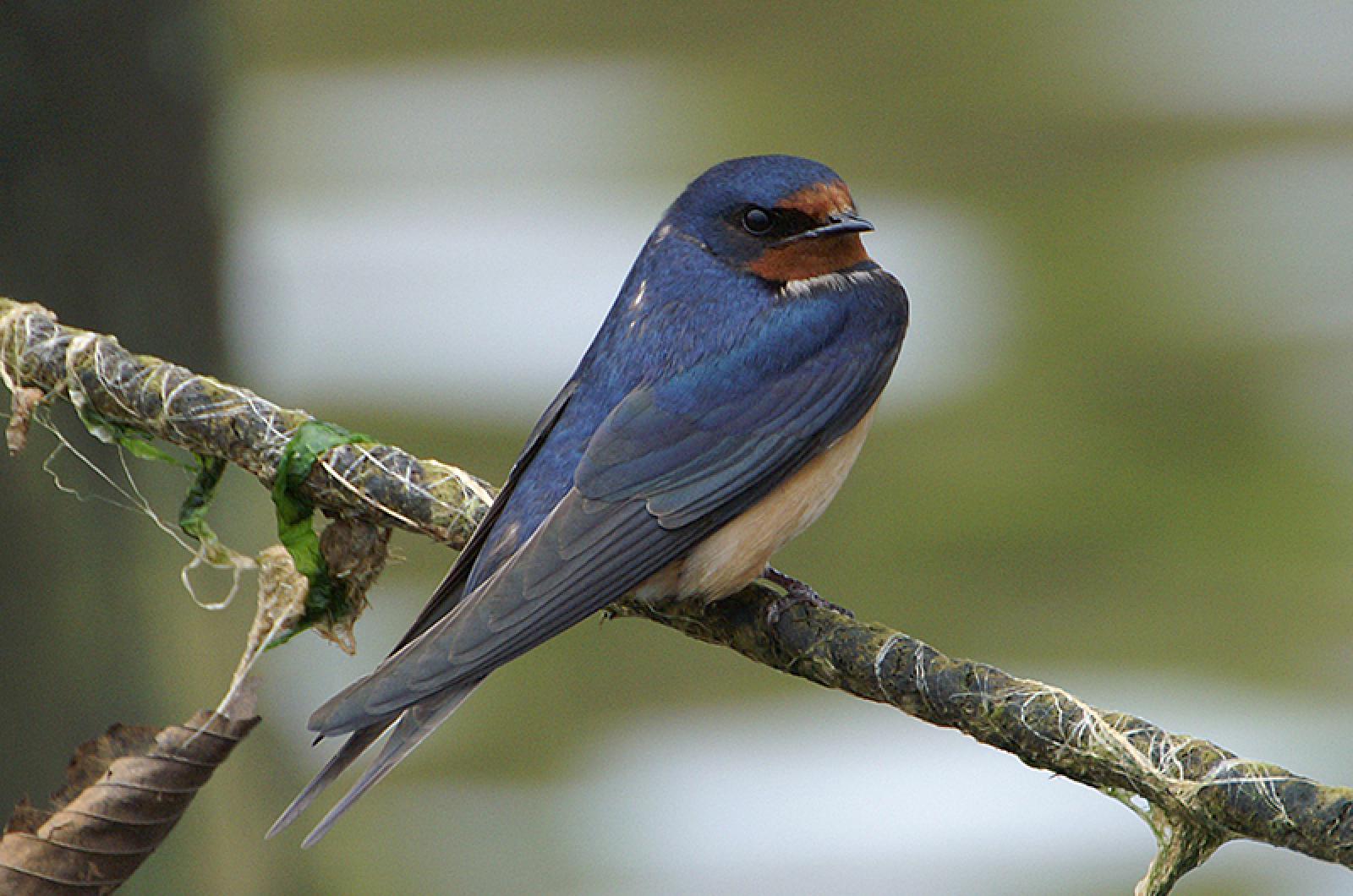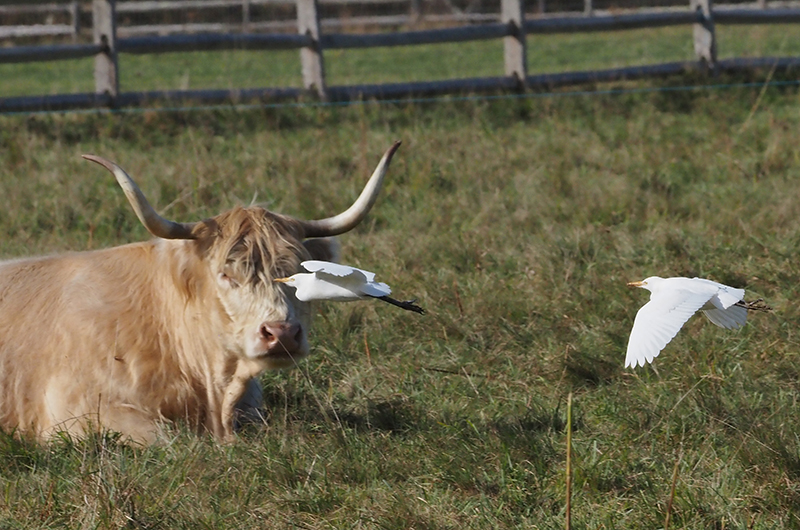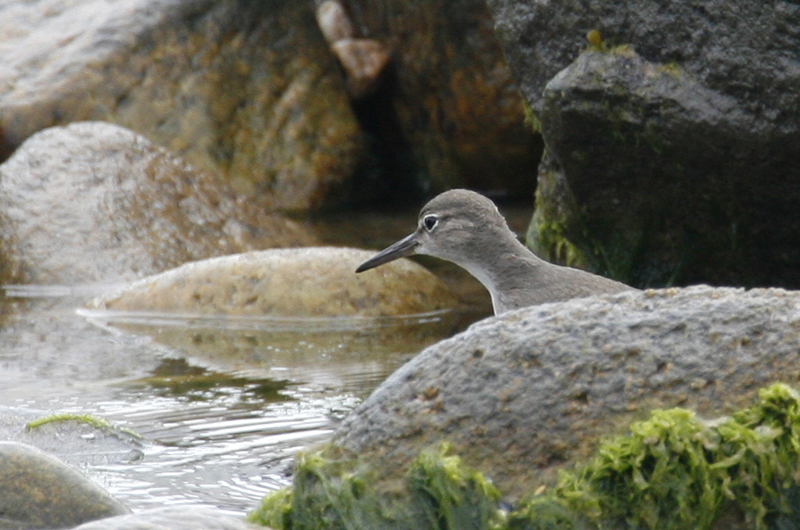I used to blame all the divots in our lawns on skunks. You know divots, those little chunks of turf that have been dug out of a lawn and flipped upside-down, as if I was practicing my golf game. I have watched skunks dig them up as they search for the grubs living among the grass roots.
On Nov. 6, I watched an American crow do the same thing at Ocean Park. It pecked viciously at the grass, loosening sod from the soil underneath. Then it grabbed the chunk of sod with its beak and tugged on it. After a couple of tugs, a two to three-square inch chunk of sod was detached from the ground, flipped upside down, and the grub-–or some other delectable morsel--was quickly swallowed.
The crow repeated this at least five times as I watched. It moved about a foot away before repeating the process. How do they know where to peck? Maybe they hear the critter moving under their feet?
A new species for the year is the cattle egret, an uplander from Africa that is now widespread across southern North America. They frequently stray northward but we do not find them every year. They are found in agricultural settings with cows and other farm animals rather than the marshes and shorelines of other egrets.
On Nov. 4, Julie Scott posted a video of cattle egrets at Slough Cove Farm, which Matt Pelikan noticed and passed the word along to others. Such unusual birds cause many of us to try to see them. That day, Matt Pelikan found three of them at Slough Cove Farm, as did Lanny McDowell, Allan Keith and Jeff Bernier. Susan Whiting found them on Nov. 5.
Multiple observers found four at Katama Farm on Nov. 7: John Nelson, Luanne Johnson, Charles and Sam Darmstadt, Isaiah Freedman, Margaret Curtin, Molly Jacobson and I all spotted them as they moved back and forth between the cattle and the sheep pastures. They were seen again on Nov. 8 by John Nelson. Where did the fourth bird come from? I believe we all thought they must be the Slough Cove birds, even though there were four of them. Did anyone checked the original site at nearby Slough Cove Farm?
Bob Shriber found another new species for the year when he saw a lark sparrow where the road to Red Beach splits from Lobsterville Road in Aquinnah on August 8. Allan Keith spotted the bird again two hours later. This species is typically found in open, grassy areas out west, breeding as far east as southwestern Ohio. They wander eastward to the Atlantic coast and Martha’s Vineyard every fall. Susan Whiting and Bob Shriber spotted another sparrow, a vesper sparrow, at Hancock Preserve on Nov. 5.
The new Martha’s Vineyard Bird Club had a field trip to Chilmark on Nov. 6. It was led by Bob Shriber and they found a pied-billed grebe, a first for the season. Eighteen people attended the walk and highlights of their sightings were wood duck, green-winged teal, greater scaup, white-rumped sandpiper, greater yellowlegs, Bonaparte’s gull, lesser black-backed gull, northern gannets, a lingering osprey and eastern bluebird.
Another new for the season species is an American coot that Charles and Sam Darmstadt and Isaiah Freedman found on Upper Chilmark Pond on Nov. 6.
Waterfowl are moving southward from their northern nesting grounds. The most recent species to arrive is the ring-necked duck, which was found by John Nelson at the Oak Bluffs Pumping Station. Other species are arriving. More than 100 brant were foraging at Ocean Park; American wigeon have been seen by John Nelson at the Oak Bluffs Pumping Station on Nov. 6 and 7. Bufflehead are found on ever-more ponds, as reported by John Nelson at Farm Pond and Sunset Lake on Nov. 6, Ellen Bunch at Farm Pond on Nov. 7 and Katie Ryan at Caleb’s Pond on Nov. 7. Red-breasted mergansers were reported by Charles and Sam Darmstadt and Isaiah Freedman at Farm Pond on Nov. 6.
Spotted sandpipers have distinctive call notes. Bob Shriber identified a spotted sandpiper by voice as it flew over Menemsha Pond at night on Nov. 6. There are only a handful of sightings of this lingering species in Massachusetts this November, although it was fairly common in August and September.
Bridget Dunnigan and Sea Williams saw a lingering songbird, an ovenbird, in the southern woodlands of Oak Bluffs on Nov. 3. This widespread breeding species is being seen later into the fall than it used to; we have even spotted one on a Christmas Bird Count a few years back. Speaking of lingering, Allan Keith saw a yellow-billed cuckoo at the Gay Head Cliffs on Nov. 3; Luanne Johnson and Margaret Curtin spotted a barn swallow at Katama Farm on Nov. 7; and Richard Price reports red-winged blackbirds along the edge of a marsh in Ocean Heights.
On the shorebird front, the golden plover that has been at Katama Farm is still there. Luanne Johnson and Margaret Curtin found it on Nov. 7 and John Nelson saw it on Nov. 8. The former observers also saw two killdeer, a flock of American pipits and 10 black-bellied plover.
On Nov. 6, the trio of Charles and Sam Darmstadt and Isaiah Freedman Eel Pond reported two American oystercatchers, 30 black-bellied plover, three sanderling, six dunlin, three greater yellowlegs and two lesser yellowlegs. The next day, Molly Jacobson added a ruddy turnstone, 75 sanderling, and 50 dunlin to that list.
At nearby Sheriff’s Meadow Sanctuary, Pete Gilmore reported three great egrets, two greater yellowlegs, one great blue heron and six black-crowned night-herons, while John Nelson spotted four greater yellowlegs and a few laughing gulls on Nov. 4, and two other greater yellowlegs on Nov. 5 at Farm Pond. He saw eight Bonaparte’s gulls in Vineyard Haven harbor.
There is so much more news to report but I will close this column with a report on an early sighting of long-tailed ducks from Daphne Gemmill, and Nancy and Russell Twist. They found six long-tailed ducks from the viewing area at the Gay Head Cliffs on Oct. 11.
Please email your sightings to birds@mvgazette.com.
Robert Culbert is an ecological consultant with Nature Watch LLC living in Vineyard Haven.








Comments
Comment policy »